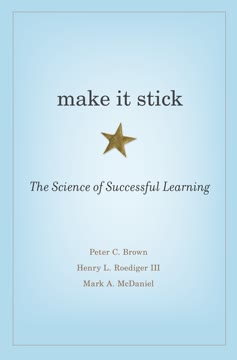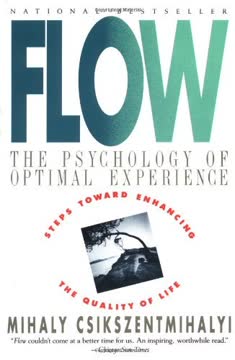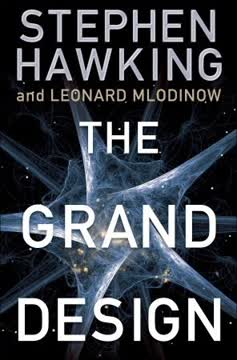Key Takeaways
1. Creativity is a deliberate process, not just innate talent
Creativity is not simply a way to make things better. Without creativity we are unable to make full use of the information and experience that is already available to us and is locked up in old structures, old patterns, old concepts, and old perceptions.
Creativity can be learned. It's not just an innate talent possessed by a gifted few, but a skill that can be developed through deliberate practice and systematic techniques. This challenges the traditional notion that creativity is solely the domain of "creative types" or geniuses.
Systematic approach to creativity. De Bono introduces lateral thinking as a set of deliberate techniques to generate new ideas and solve problems. These techniques are based on understanding how the brain works as a self-organizing pattern-making system, and they provide a structured way to break out of habitual thinking patterns.
Key components of deliberate creativity:
- Understanding the logic and nature of creativity
- Learning specific tools and techniques
- Regular practice and application
- Willingness to challenge existing patterns and perceptions
2. Lateral thinking techniques break traditional thought patterns
You cannot dig a hole in a different place by digging the same hole deeper.
Breaking established patterns. Lateral thinking is about moving sideways to find different perceptions, concepts, and points of entry. It's a deliberate effort to think differently, rather than just trying harder along the same lines of thought.
Complementing vertical thinking. While vertical thinking (logical, step-by-step reasoning) is valuable, it's often insufficient for generating truly new ideas. Lateral thinking techniques provide ways to:
- Escape from established thought patterns
- Generate alternative perspectives
- Make unexpected connections
- Challenge assumptions
These techniques include tools like provocation, random entry, and concept extraction, which help thinkers explore possibilities beyond the obvious and logical.
3. Challenge assumptions and escape from conventional thinking
I want ways of reducing the paperwork.
Question the status quo. The creative challenge is about questioning why things are done in a certain way, even when they seem to be working fine. It's not about criticism, but about exploring alternatives and possibilities.
Escape method. This technique involves identifying things we take for granted and then deliberately escaping from them. For example:
- Take for granted: Restaurants have food
- Escape: Po, restaurants do not have food
- New idea: Indoor picnic restaurant where customers bring their own food
By systematically challenging assumptions, we can:
- Uncover hidden opportunities
- Rethink established processes
- Generate novel solutions to old problems
- Break free from "the way it's always been done"
4. Use provocations to generate new ideas and concepts
Po, cars should have square wheels.
Deliberate provocation. The word "po" signals a provocation – an intentionally unreasonable statement used to break out of normal thinking patterns. It's a way to be temporarily "mad" in a controlled way to generate new ideas.
Movement from provocation. After stating a provocation, use specific techniques to move from the provocative statement to potentially useful ideas:
- Extract a principle
- Focus on the difference
- Moment to moment
- Positive aspects
- Circumstances
For example, from "cars with square wheels," we might consider the concept of adjustable suspension, leading to ideas for vehicles that can adapt to rough terrain.
5. Random input can stimulate creative connections
The random input technique is one of the provocative techniques but the way it works is slightly different from the other provocative techniques.
Unexpected connections. The random input technique involves introducing an unrelated word or concept to the problem at hand. This forces the brain to make new connections and can lead to surprisingly innovative ideas.
Simple yet powerful. Despite seeming illogical, this technique is based on how the brain works as a pattern-making system. It's easy to use and can be highly effective:
- Define your focus or problem
- Choose a random word (e.g., from a dictionary)
- Force connections between the word and your focus
- Explore the ideas that emerge
Example:
- Focus: Improving office copiers
- Random word: "Nose"
- New idea: Copiers that use scent to signal different types of malfunctions
6. Focus on concepts, not just ideas, for innovative solutions
Concepts are very like road junctions. We pull back to the junction to find another way forward.
Concept extraction. Instead of fixating on specific ideas, it's crucial to "pull back" and identify the underlying concepts. This allows for more flexibility and broader application of creative thinking.
Working with concepts:
- Generate ideas
- Extract concepts from those ideas
- Explore alternative ways to implement the concepts
- Generate new ideas based on the concepts
Benefits of focusing on concepts:
- Allows for more versatile problem-solving
- Helps identify transferable principles
- Encourages thinking at a higher level of abstraction
- Leads to more fundamental innovations
7. Creativity requires both individual effort and group dynamics
In my experience, individuals working on their own produce far more ideas and a far wider range of ideas than when they are working together in a group.
Balance individual and group creativity. While group brainstorming has been traditionally emphasized, individual creative effort is often more productive for generating initial ideas.
Effective creative process:
- Individual ideation: People work alone to generate ideas using lateral thinking techniques
- Group sharing: Individuals present their ideas to the group
- Group development: The team builds on and refines the presented ideas
- Iteration: Repeat the process as needed
Benefits of this approach:
- Leverages both individual creativity and group synergy
- Reduces social inhibitions that can limit idea generation in groups
- Allows for a wider range of ideas to be explored
- Promotes ownership and engagement from all participants
8. Implement structures and programs to foster organizational creativity
Creativity is a "good thing" and no one is really against creativity. Everyone needs creativity, so creativity is everyone's business. For precisely these reasons creativity ends up being no one's business and nothing happens.
Make creativity systematic. To truly harness creativity in an organization, it's necessary to implement specific structures and programs rather than relying on sporadic efforts or individual talents.
Key elements for fostering organizational creativity:
- Creative Hit List: A formal list of defined creative need areas
- Creativity Center: A dedicated department for enhancing creativity
- Process Champion: A senior executive responsible for driving creative initiatives
- Regular Creative Sessions: Scheduled meetings focused on generating new ideas
- Training Programs: Systematic development of creative thinking skills
- FAT/CAT Program: Fixed Assigned Tasks for Creative Action Teams
These structures create a framework for:
- Making creativity an expectation rather than an exception
- Providing clear channels for creative output
- Ensuring continuous focus on innovation and improvement
9. Train and develop creative thinking skills systematically
Skill training is always training "from the center." This is in marked contrast to normal subject teaching, which is teaching "from the edge."
Deliberate skill development. Creative thinking skills can and should be taught systematically, much like any other skill. This involves understanding the underlying principles and practicing specific techniques.
Training approaches:
- Sensitization: Exposing people to the importance and logic of creativity
- Technique Training: Teaching specific lateral thinking tools
- Practice: Guided application of techniques to various problems
- Integration: Incorporating creative thinking into daily work
Key aspects of effective creativity training:
- Focus on practical, usable techniques
- Provide ample opportunity for practice
- Teach both the logic and application of creative methods
- Tailor training to different organizational needs (e.g., general skills vs. specialized creative roles)
By investing in systematic creativity training, organizations can build a culture of innovation and equip their people with the tools to tackle complex challenges in new ways.
Last updated:
FAQ
What's Serious Creativity about?
- Focus on Creativity: Serious Creativity by Edward de Bono emphasizes the importance of creative thinking in various fields, including business, education, and government.
- Lateral Thinking Techniques: It introduces systematic techniques for generating new ideas and changing perceptions through lateral thinking.
- Practical Applications: The book provides tools like the Six Thinking Hats and the Concept Fan to enhance creative thinking capabilities.
Why should I read Serious Creativity?
- Enhance Problem-Solving Skills: The book teaches how to think creatively and approach challenges from new perspectives.
- Applicable in Various Fields: Techniques are useful across different domains, making it valuable for professionals in business, education, and beyond.
- Structured Approach: Offers a systematic method to generate ideas and improve decision-making processes.
What are the key takeaways of Serious Creativity?
- Lateral Thinking Definition: Defined as solving problems by unorthodox or illogical methods, encouraging breaking free from conventional thought patterns.
- Importance of Provocation: Emphasizes provocation in creativity, exploring ideas that may seem absurd but lead to innovative solutions.
- Creative Pause and Focus: Introduces "creative pause" and "simple focus" to enhance creative output by reflecting and considering alternatives.
What is lateral thinking, as defined in Serious Creativity?
- Creative Problem-Solving: A method of generating new ideas by breaking away from traditional logical reasoning.
- Provocation and Movement: Uses provocations to stimulate thought and movement to explore new possibilities.
- Systematic Approach: Presented as a teachable and applicable method, making it accessible to everyone.
What are the Six Thinking Hats in Serious Creativity?
- Color-Coded Thinking: Uses different colored hats to represent various modes of thinking: White (information), Red (feelings), Black (caution), Yellow (optimism), Green (creativity), and Blue (process control).
- Structured Discussions: Allows groups to focus on one type of thinking at a time, reducing conflict and enhancing collaboration.
- Encourages Diverse Perspectives: Ensures all aspects of a problem are considered before making decisions.
How does the Concept Fan work in Serious Creativity?
- Layered Approach: Helps generate ideas by starting with a broad objective and breaking it down into concepts and specific ideas.
- Fixed Points: Each layer represents a fixed point, from general direction to specific ideas, systematically exploring possibilities.
- Encourages Creativity: Identifies new ways to achieve objectives and develop innovative solutions.
What is the Creative Pause in Serious Creativity?
- Deliberate Reflection: Encourages stopping to reflect on the thinking process, allowing for new ideas and alternatives.
- Investment in Creativity: Pausing can lead to significant insights and creative breakthroughs.
- Building a Habit: Regular practice helps develop a habit of creative thinking, making idea generation easier.
What is the escape method mentioned in Serious Creativity?
- Challenging Assumptions: Involves identifying "taken-for-granted" elements and deliberately negating them to provoke new ideas.
- Generating Fresh Perspectives: Encourages exploring alternative approaches not previously considered.
- Practical Application: Can be applied in various contexts, prompting individuals to think outside the box.
How can organizations implement the techniques from Serious Creativity?
- Training Programs: Establish programs to teach employees lateral thinking techniques, integrating creativity into corporate culture.
- Creative Hit Lists: Identify areas needing creative attention, providing a structured approach to idea generation.
- Regular Creative Sessions: Schedule sessions to practice techniques and continuously develop creative skills.
What is the significance of harvesting ideas in Serious Creativity?
- Maximizing Value: Systematically record and evaluate creative session outputs to ensure valuable concepts are not overlooked.
- Categorizing Ideas: Ideas are categorized into specific, "for-instance," seedling, and concept ideas for better understanding.
- Facilitating Future Creativity: Maintains a repository of concepts for future development, enhancing overall creativity.
What are some common misperceptions about creativity according to Edward de Bono?
- Natural Talent vs. Teachability: Creativity is often seen as a natural talent, but de Bono argues it can be developed through training.
- Craziness and Creativity: Creativity is not just about "crazy" ideas; it is a serious process that can be structured and refined.
- Right Brain/Left Brain Myth: Challenges the idea that creativity is solely a right-brain function, involving both hemispheres.
What role does confidence play in the creative process according to Serious Creativity?
- Building Fluency and Skill: Confidence is essential for developing fluency and skill in creative thinking.
- Acknowledging Failures: Recognizing when creative efforts don't yield results can build confidence and resilience.
- Encouraging Experimentation: A confident mindset fosters experimentation, leading to more innovative outcomes.
Review Summary
Serious Creativity receives mixed reviews, with an average rating of 3.82/5. Readers appreciate de Bono's innovative approach to creative thinking and the practical tools provided. Many find the content valuable but criticize the writing style as repetitive and dry. Some praise the book's comprehensive coverage of creative techniques, while others feel it's outdated. The book is seen as particularly useful for business applications. Critics note that some ideas have become commonplace in design thinking, but supporters argue that de Bono's methods have broader applications.
Similar Books










Download PDF
Download EPUB
.epub digital book format is ideal for reading ebooks on phones, tablets, and e-readers.













